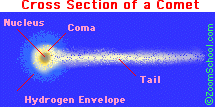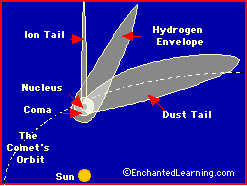|
A comet is a small, icy celestial body
that orbits around the sun. They are among the least-changed objects in our solar system and, as such, may yield important
clues about the formation of our solar system. Impacts
from comets played a major role in the evolution of the Earth, primarily during its early history billions of years ago. Some
believe that they brought water and a variety of organic molecules to Earth.
 A comet is made up of a nucleus (solid, frozen ice, gas and dust), a gaseous coma (water vapor, CO2, and other gases) and a long tail (made of dust and ionized gases). A comet is made up of a nucleus (solid, frozen ice, gas and dust), a gaseous coma (water vapor, CO2, and other gases) and a long tail (made of dust and ionized gases).
The tail develops when the comet is near the
Sun. Its long ion tail of always points away from the sun, because of the force of the solar wind. The tail can be up to 250 million km long, and is most
of what we see. Comets are only visible when they're near the sun in their highly eccentric orbits.
PARTS OF A COMET
 Nucleus: The nucleus is the frozen center of a comet's head. It is composed of ice, gas, and dust. The nucleus
contains most of the comet's mass but is very small (about 1 to 10 km across - or more). Nucleus: The nucleus is the frozen center of a comet's head. It is composed of ice, gas, and dust. The nucleus
contains most of the comet's mass but is very small (about 1 to 10 km across - or more).
Coma: The coma is the roughly spherical
blob of gas that surrounds the nucleus of a comet; it is about a million km across. The coma is comprised of water vapor,
carbon dioxide gas, ammonia, dust, and neutral gases that have sublimed from the solid nucleus. The coma and the nucleus form
the head of a comet.
Ion Tail: A tail of charged gases
(ions) always faces away from the sun because the solar wind (ions streaming from the sun at high velocities) pushes it away
(it is also called the plasma tail). When the comet is approaching the Sun, the ion tail trails the comet: when the comet
is leaving of the Sun, the ion tail leads. The tail fades as the comet moves far from the Sun. The ion tail can be well over
100 million km long.
Dust Tail: The dust tail is a long,
wide tailcomposed of microscopic dust particles that are buffeted by photons emitted from the Sun; this tail curves slightly
due to the comet's motion. The tail fades as the comet moves far from the Sun.
Hydrogen Envelope: Hydrogen gas surrounds
the coma of the comet and trails along for millions of miles (it is usually between the ion tail and the dust tail). The hydrogen
envelope is about 10 million km across at the nucleus of the comet and about 100 million km long. It is bigger when the comet
is near the Sun.
A COMET'S ORBIT
We can predict the orbits of many comets, but
not all. Comets orbit the Sun in highly elliptical orbits. Their velocity increases greatly when they are near the Sun and
slows down at the far reaches of the orbit. Since the comet is light only when it is near the Sun (and is it vaporizing),
comets are dark (virtually invisible) throughout most of their orbit. The solar wind pushes the tail away from the Sun.
Some
comets crash into the Sun or get so close that they burn up; these comets are called sungrazers.
COMET EXPLORATION
NASA's Stardust Mission will visit the Comet Wild 2 in 2004. It will take a sample
of comet particles and return them to Earth. The small spacecraft (about 770 pounds = 350 kg) was launched February 7, 1999
and rendezvoused with comet Wild 2 in January, 2004. It will return to Earth on January 15, 2006, and land in western Utah,
USA. Comet Wild 2 (aka Comet 81P) is a short-period comet that was discovered by the Swiss astronomer Paul Wild on January
6, 1978. The comet's nucleus is about 3 miles (5 km) across. Wild 2 orbits the Sun every 6.39 years; its elliptical orbit
ranges from about Mars' orbit to Jupiter's orbit.
COSMIC SNOWBALLS
There is a new and very controversial theory that
comets (composed of frozen water) are constantly bombarding the Earth. These "cosmic snowballs" have (perhaps) been seen by
the visible imaging system of the Polar Satellite. In theory, these frozen comets vaporize in the atmosphere, adding water
vapor to the environment.
Around a dozen "new" comets are discovered each year.
Long-period Comets (comets with an orbital period over 200 years and up to 30 million years): The Oort
Cloud is a cloud of rocks and dust that may surround our solar system. This cloud may be where long-period comets originate.
The Oort Cloud was named for Jan H. Oort, who proposed its existence in 1950. It has been hypothesized that the Oort Cloud
is responsible for the periodic mass extinctions on Earth.
Short-period Comets (comets with an orbital
period under 200 years): The Kuiper belt is a region beyond Neptune in which at least 70,000 small
objects orbit. This belt is located from 30 to 50 (?) A.U.'s and was discovered in 1992. It is a region where the planet-building
process was stopped in before any large objects were formed; there are only primitive remnants from the early accretion disk of the solar system, 4.5 billion years ago. The Kuiper
belt may be the source of the short-period comets (like Halley's comet). The Kuiper belt was named for the Dutch-American astronomer
Gerard P. Kuiper, who predicted its existence in 1951.
MAJOR COMETS:
HALLEY'S COMET
Halley's comet is a periodic comet (made
of frozen gas and dust), that orbits around the sun. Its earliest-recorded sighting was in 240 B.C. in China, but Edmund Halley
was the first person to recognize that it was periodic. It was last seen in 1986 and will be seen next in the year 2061; its
period is 76 years. When the Earth passes through Halley's comet's orbit (twice each year), its detritus causes the meteor showers the Eta Aquarids and the Orionids.
SHOEMAKER-LEVY
9
Shoemaker-Levy 9 (SL-9) was a short-period comet that was discovered by Eugene and Carolyn Shoemaker and
David H. Levy. As the comet passed close by Jupiter, Jupiter's gravitational forces broke the comet apart . Fragments of the
comet collided with Jupiter for six days during July, 1994, causing huge fireballs
in Jupiter's atmosphere that were visible from Earth.
COMET LINEAR
Comet LINEAR [designated C/1999 S4 (LINEAR)] was a
comet that broke apart when it approached the Sun. The comet's icy core disintegrated as it passed close
to the Sun (its perihelion) in July 2000. The Sun's intense heat had more to do with
this comet's break-up than the Sun's gravitational forces.
HALE-BOPP COMET
Hale Bopp (designated C/1995 O1) is a periodic
comet that orbits around the sun. Its earliest-recorded sighting was on July 23, 1995. It was independently discovered by
Alan Hale (of New Mexico) and Thomas Bopp (of Arizona), both amateur astronomers. This comet has a diameter of about 40 km;
it's rotation rate is 11.4 hours. It was last seen in 1997 and will be seen next in the year 4377; its period is 2380 years.
|

